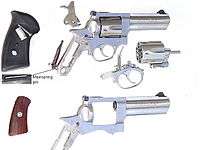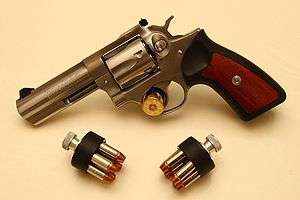Ruger GP100
| GP100 | |
|---|---|
|
Ruger KGP-141 with speed loaders of .357 ammunition. | |
| Type | Revolver |
| Place of origin | United States |
| Production history | |
| Manufacturer | Sturm, Ruger & Co.[1] |
| Produced | 1985–present [1] |
| Variants | See Models |
| Specifications | |
| Weight | 36–45 oz (1,000–1,300 g)[2] |
| Length |
8.5 in (22 cm)[2] 9.5 in (24 cm)[2] 11.5 in (29 cm)[2] |
| Barrel length |
3 in (7.6 cm)[2] 4.2 in (11 cm)[2] 6 in (15 cm)[2] |
|
| |
| Cartridge |
.357 Magnum / .38 Special .327 Federal Magnum[2] |
| Action | Double-action revolver |
| Effective firing range | 55–110 yd (50–100 m) |
| Maximum firing range | +/- 550 yd (500 m) |
| Feed system |
6-shot cylinder (.357 Mag & .38 Spl) 7-shot cylinder (.327 Fed Mag)[2] |
The GP100 is a family/line of double action six-shot (.357 Magnum) seven-shot (.327 Federal Magnum) or ten-shot (.22 LR) revolvers made by Sturm, Ruger & Co., manufactured in the United States. It was introduced in 1985 as a second generation of the Ruger double-action, exposed-hammer revolvers intended to replace Ruger's Security- / Service- / Speed-Six line. It was made stronger with the intent to fire an unlimited number of full-power .357 Magnum rounds and has been produced in a number of variations with three basic barrel lengths (3 in / 76 mm, 4 in / 102 mm, and 6 in / 152 mm), various barrel profiles (full lug and half lug), fixed or adjustable sights, and in blued carbon steel or polished stainless steel.
Description and features
The GP100 was an evolution of an earlier Ruger double-action revolver, the Security Six. The first significant change was introduced with the Ruger Redhawk and that involved a new locking mechanism with a lever on the crane rather than using the end of the ejector rod to lock. Another change was the shape of the frame. Traditional revolver frames had exposed metal at the front and rear of the grips, with the frame determining the shape of the grips. This meant that to have a round butt concealed carry version and a square butt holster or target version of the same gun usually meant having two different frame shapes. The GP100 series, instead, used a small rectangular "peg" grip large enough to enclose the hammer spring and strut. The grips could then be any shape desired, as long as they were large enough to enclose the peg. This was not a new innovation having been used by Dan Wesson and, to some degree, by High Standard revolvers that predated the GP100. The Dan Wesson patent (U.S. Patent 3,683,535) was granted in 1972 and Ruger's patent (U.S. Patent 4,625,445) was granted in 1986.
The stock grips are made of Santoprene, a soft, chemical resistant elastomer that helped absorb the recoil of firing. Panels on the side, made of black plastic, goncalo alves wood or rosewood, provide contrast to the flat black of the Santoprene. The grips are now Hogue one piece rubber grips standard. (Ruger Website)[3]
The GP100 shared the crane lock from the Redhawk that was later used in the small frame SP101 revolver. All of these models use the same thickness on the solid frame and double latching system as used on the heavy .44 Magnum. Because of these features, the GP100 series is widely described as one of the strongest medium frame revolvers ever made.[3]
The GP100 is manufactured in .357 Magnum, .38 Special, .22 Long Rifle, and .327 Federal Magnum calibers. Available Barrel lengths are 3" (76mm), 4.2" (107mm) and 6" (152mm) with partial or full length underlugs.[4] Blued Steel, or Stainless Steel finishes are available with stainless model numbers preceded by a "K". The Firing pin of the GP100 is mounted inside the frame. The Transfer bar of the GP100 is connected directly to the trigger. The transfer bar must be present between the hammer and the firing pin in order for the cartridge to be fired. The transfer bar only assumes the required position when the trigger is pulled completely rearward. GP100 models are available with fixed or adjustable sights. Fixed sight models are designated by a "F" suffix model number. When the cylinder is closed and the gun is at the point of firing, the cylinder crane is locked into the frame at the front and rear of the crane and by the cylinder lock at the bottom of the crane opening. The GP100 disassembles into three major modules with only limited use of tools. This allows the user to easily clean the revolver after shooting. The design of the gun eliminates the need for a frame "sideplate", a feature which contributes to the GP100's reputation for strength.[3]
Specifications

- Weight: 2.2 lbs (1000 g 4", 1300 g 6") The type of sights and barrel profile affect the weight of the revolver. These are representative weights in the most common configurations.
- Barrel lengths: 3" (76mm), 4.2" (107mm), 5" (127mm), and 6" (152mm).[4] The run of 5" GP100 revolvers was made for the distributor, Davidson's.[5]
- Double Action. The GP100 may be fired by either cocking the hammer and subsequently pulling the trigger (a.k.a. Single Action), or by merely pulling the trigger when the hammer is not cocked.
- Maximum effective range: 55 to 110 yards (50 to 100 meters) depending on barrel length, cartridge load, and additional optical sights. Projectiles from this weapon can still be dangerous up to several thousand yards from the muzzle under optimum conditions. The quoted range is more a function of the useful range of a typical handgun than a statement of the maximum lethal range of the projectiles.
- 6-Shot .357 Magnum and .38 Special
- 7-Shot .327 Federal Magnum
Models
| Catalog Number | Caliber | Barrel Length[4] | Finish | Sights | Weight | Shroud |
|---|---|---|---|---|---|---|
| GP-141 | .357 Mag. | 4.4" | Blued | Adj. sight | 40 oz | Full Shroud |
| GP-161 | .357 Mag. | 6" | Blued | Adj. sight | 45 oz | Full Shroud |
| GPF-840 | .38 | 4" | Blued | Fixed sight | 37 oz | Half Shroud |
| GPF-841 | .38 | 4" | Blued | Fixed sight | 38 oz | Full Shroud |
| KGP-141 | .357 Mag. | 4.2" | Stainless | Adj. sight | 40 oz | Full Shroud |
| KGP-151 | .357 Mag. | 5" | Stainless | Adj. sight | 42 oz | Full Shroud |
| KGP-161 | .357 Mag. | 6" | Stainless | Adj. sight | 45 oz | Full Shroud |
| KGPF-331 | .357 Mag. | 3" | Stainless | Fixed sight | 36 oz | Full Shroud |
| GPNY | .38 | 3" & 4" | Stainless | Fixed sight | 36~37 oz | Full Shroud |
| KGP-4327-7 | .327 Fed. Mag. | 4.2" | Satin Stainless | Adj. sight | 40 oz | Full Shroud |
| 1757 | .22 Long Rifle | 5.5" | Satin Stainless | Adj. sight | 42 oz | Half Shroud |
^ Caliber: .357 Magnum GP100s handle all .357 Magnum factory loads and accept factory .38 Special cartridges.
^ The .357 Magnum, four inch barreled model was standard issue to uniformed officers of the former U.S. Immigration and Naturalization Service[6] as well as Patrol Agents of the U.S. Border Patrol until both agencies adopted .40 caliber semi-automatic pistols.[7]
^ Not on CA DOJ approved list
^ Special design for the New York City Police Department in .38 with a spurless hammer, double-action only. Never issued to service officers. Ruger stainless double action only Service-Six revolvers chambered in .38 Special were issued from July 1987 until approximately 1990–1991, when 9mm semi-automatics were phased in. Some officers still carry the stainless spurless Ruger and Smith & Wesson revolvers by choice and are being phased out as they retire.
Users
-
 Greece: EKAM counter-terrorist unit of the Hellenic Police[8]
Greece: EKAM counter-terrorist unit of the Hellenic Police[8] -
 United States: Used by some NYPD officers. The .357 magnum, 4-inch barreled model was issued by the United States Border Patrol to its patrol agents as well as to the uniformed officers of the former U.S. Immigration and Naturalization Service[6] up until the early 1990s and used until both agencies switched to .40 caliber semi-automatic pistols.[7]
United States: Used by some NYPD officers. The .357 magnum, 4-inch barreled model was issued by the United States Border Patrol to its patrol agents as well as to the uniformed officers of the former U.S. Immigration and Naturalization Service[6] up until the early 1990s and used until both agencies switched to .40 caliber semi-automatic pistols.[7]
Gallery
 GP100 (mod. KGP-161) revolver.
GP100 (mod. KGP-161) revolver. GP100 (KGP-161) with opened cylinder and .357 Magnum ammunition.
GP100 (KGP-161) with opened cylinder and .357 Magnum ammunition. Ruger GP100 revolver adjustable rear sight.
Ruger GP100 revolver adjustable rear sight.
References
- Wilson, R. L.; G. Allan Brown (2008). Ruger & His Guns: A History of the Man, the Company and Their Firearms. Book Sales, Inc. ISBN 978-0-7858-2103-8.
- 1 2 Peterson, Philip. Gun Digest Book of Modern Gun Values: The Shooter's Guide to Guns 1900 to Present (16th ed.). p. 242.
- 1 2 3 4 5 6 7 8 9 "Ruger GP100". Sturm, Ruger & Co., Inc. Retrieved 8 December 2012.
- 1 2 3 Sweeney, Patrick (2007). Gun Digest Book of Ruger Pistols and Revolvers. Iola, Wisconsin: Gun Digest Books. pp. 172–174. ISBN 978-0-89689-472-3.
- 1 2 3 Ruger GP100 Double-Action Revolver Models at Ruger.com
- ↑ "Ruger GP100 Double Action Revolver". Gallery of Guns. Davidson's. Retrieved 2011-11-16.
- 1 2 Former I&NS Special Agent
- 1 2 Former Border Patrol Agent
- ↑ "Greece Ministry of Public Order Press Office: Special Anti-Terrorist Unit" (PDF). http://astynomia.gr - Official Website of the Hellenic Police. July 2004. Retrieved 2009-10-13. External link in
|publisher=(help)
External links
| Wikimedia Commons has media related to: |
- Ruger's GP100 page
- Ruger-produced Dissembly video
- Ruger-produced Cleaning video
- Ruger-produced Reassembly video

